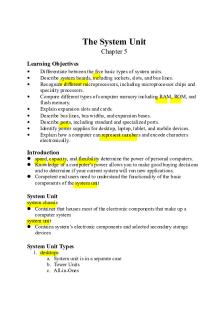Chapter 5 - DSM-5 Diagnostic Criteria for Panic Disorder PDF

| Title | Chapter 5 - DSM-5 Diagnostic Criteria for Panic Disorder |
|---|---|
| Course | Psychology |
| Institution | University of Pretoria |
| Pages | 2 |
| File Size | 64.8 KB |
| File Type | |
| Total Downloads | 22 |
| Total Views | 146 |
Summary
Download Chapter 5 - DSM-5 Diagnostic Criteria for Panic Disorder PDF
Description
4. DSM-5 Diagnostic Criteria for Panic Disorder A. Recurrent unexpected panic attacks. A panic attack is an abrupt surge of intense fear or intense discomfort that reaches a peak within minutes, and during which time four (or more) of the following symptoms occur: Note: The abrupt surge can occur from a calm state or an anxious state.
1. Palpitations, pounding heart, or accelerated heart rate. 1. Sweating. 2. Trembling or shaking. 3. Sensations of shortness of breath or smothering. 4. Feelings of choking. 5. Chest pain or discomfort. 6. Nausea or abdominal distress. 7. Feeling dizzy, unsteady, light-headed, or faint. 8. Chills or heat sensations. 9. Paresthesia’s (numbness or tingling sensations). 10. De-realization (feeling of unreality) or depersonalization (being detached from oneself). 11. Fear of losing control or “going crazy”. 12. Fear of dying.
Note: Culture-specific symptoms (e.g., tinnitus, neck soreness, headache, uncontrollable screaming or crying) may be seen. Such symptoms should not count as one of the four required symptoms.
A. At least one of the attacks has been followed by 1 month (or more) of one or both of the following:
1. Persistent concern or worry about additional panic attacks or their consequences (e.g., losing control, having a heart attack, “going crazy”). 13.A significant maladaptive change in behavior related to the attacks (e.g., behaviors designed to avoid having panic attacks, such as avoidance of exercise or unfamiliar situations).
B. The disturbance is not attributable to the physiological effects of a substance (e.g., a drug of abuse, a medication) or another medical condition (e.g., hyperthyroidism, cardiopulmonary disorders). C. The disturbance is not better explained by another mental disorder (e.g., the panic attacks do not occur only in response to feared social situations, as in social anxiety disorder; in response to circumscribed phobic objects or situations, as in specific phobia; in response to obsessions, as in obsessivecompulsive disorder; in response to reminders of traumatic events, as in posttraumatic stress disorder; or in response to separation from attachment figures, as in separation anxiety disorder)....
Similar Free PDFs

Case Study 148 Panic Disorder
- 4 Pages

MEC Criteria for Contraceptives
- 4 Pages

Chapter 34 Diagnostic Testing
- 7 Pages

Chapter+5 - notes for chapter 5
- 8 Pages

Gabbard Riassunto DSM5
- 90 Pages

Chapter 8 Skin disorder
- 11 Pages

Panic essay cognitive model
- 7 Pages
Popular Institutions
- Tinajero National High School - Annex
- Politeknik Caltex Riau
- Yokohama City University
- SGT University
- University of Al-Qadisiyah
- Divine Word College of Vigan
- Techniek College Rotterdam
- Universidade de Santiago
- Universiti Teknologi MARA Cawangan Johor Kampus Pasir Gudang
- Poltekkes Kemenkes Yogyakarta
- Baguio City National High School
- Colegio san marcos
- preparatoria uno
- Centro de Bachillerato Tecnológico Industrial y de Servicios No. 107
- Dalian Maritime University
- Quang Trung Secondary School
- Colegio Tecnológico en Informática
- Corporación Regional de Educación Superior
- Grupo CEDVA
- Dar Al Uloom University
- Centro de Estudios Preuniversitarios de la Universidad Nacional de Ingeniería
- 上智大学
- Aakash International School, Nuna Majara
- San Felipe Neri Catholic School
- Kang Chiao International School - New Taipei City
- Misamis Occidental National High School
- Institución Educativa Escuela Normal Juan Ladrilleros
- Kolehiyo ng Pantukan
- Batanes State College
- Instituto Continental
- Sekolah Menengah Kejuruan Kesehatan Kaltara (Tarakan)
- Colegio de La Inmaculada Concepcion - Cebu








